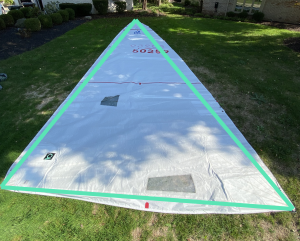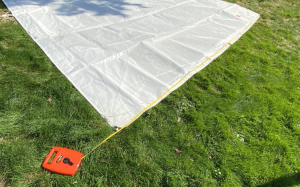Many sailors simply pull their sail measurements off their old sails when it’s time to order a new sail. But what if your old sails were lost or destroyed? What if you weren’t happy with the performance or shape of the old sails, or if you are ordering sails for a newly built vessel that has never had sails before? In this article, we are going to discuss how to get measurements from your sailboat for a new mainsail.
In order to gather the right information to order a new mainsail, you will need to take a variety of measurements as well as collect information on details like the outhaul and the type of sail slides. Keep reading to learn everything you’ll need to know about how to take the measurements for a new mainsail from your sailboat.
 Types of Measurements Required for a New Mainsail
Types of Measurements Required for a New Mainsail
There are three types of measurements that you will need to take in order to construct a new mainsail. These are the rig specs, existing mainsail measurements (if you have one), and the rig measurements. Let’s take a closer look at each of these types of measurements.
The rig specs are the first thing you’ll want to find. These are used to make sure that the sail loft has quoted you for the correct size of sail and that the measurements taken were accurate. You can get your rig specs from your boat manufacturer, online, or in your boat manual.
If you already have an existing mainsail, that will help a lot with getting the right measurements. You can compare measurements taken from the existing sail with measurements taken from your rig to make sure the new sail is cut right. You’ll need to measure the luff (leading edge of the sail), the leech (trailing edge of the sail) and the foot (bottom edge of the sail).
Lastly come the rig measurements, like the maximum luff, maximum leech, and the length of the backstay. You will also want to collect information on things like the type and size of your sail slides, and the outhaul and clew attachments. We will go over these measurements in further detail in the sections below.
Maximum Luff, Maximum Leech and Backstay Measurements
The three most important measurements you will need to take from the rig are the maximum luff, maximum foot, and backstay measurements. Let’s start with the maximum luff. You take this measurement by hauling a tape measure up your mainsail halyard until you get to the top and measuring all the way down to the top of your boom. You can measure for the maximum leech the same way, except you measure from the aft end of the top of the mast down to the longest outhaul setting. While you are taking this measurement it is a good time to also measure your backstay, since you are already at the top of your mast. This helps the sailmaker know the maximum roach that the sail can have before hitting the backstay.
 Outhaul, Clew Attachment and Sail Slide Measurements
Outhaul, Clew Attachment and Sail Slide Measurements
You have now taken all of the most important measurements for your new sail. However, there are still some more data points that need to be collected in order for you to get the best possible fit for your new sail. There are two different types of outhaul attachments, either a shackle style connection or a car style connection. Take note of what type of outhaul attachment your boat has and let your sailmaker know.
Next, it’s time to take a look at the tack connections. The sailmaker will need this data to know where to put the tack ring on the sail. In order to measure the location of the tack attachment point, measure back from the mast to the bearing point of the tack fitting and measure up from the boom to your tack bearing point. You can measure the appropriate location for the reef hooks using the same technique.
After you have finished with these measurements, you will want to take a close look at your mainsail track. The new sail will need to have slides that are appropriate for the existing track. Sail slides can come in round, flat, external, half round, or bolt rope style, where you feed the sail directly into the track. The sail slides will need to be the right style and size for your mainsail track or you won’t be able to hoist the sail. If you aren’t sure what slides are supposed to be used with your mainsail track, ask an experienced sailing friend or your sailmaker for help. If your clew attachment is a shackle, you can use the same technique to measure for the clew attachment slug.
Mast Rake and Mast Bend Measurements
The final measurements that the sailmaker will need to know are the mast rake and mast bend measurements. A professional sail designer will know how to get this information from a picture taken of the side of the vessel and rig. They can also measure the mast rake by using a plumb bob.
That’s it! A mainsail is a significant purchase that you hope to use for many years. By taking the time to measure both your old sails and your rig prior to ordering a new mainsail, you can ensure that you will get the best possible fit for your new sail. It will all be well worth it the first time you hoist your new mainsail, and watch as the perfectly shaped sail fills with wind!

